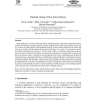Free Online Productivity Tools
i2Speak
i2Symbol
i2OCR
iTex2Img
iWeb2Print
iWeb2Shot
i2Type
iPdf2Split
iPdf2Merge
i2Bopomofo
i2Arabic
i2Style
i2Image
i2PDF
iLatex2Rtf
Sci2ools
CAGD
2002
2002
Optimal slicing of free-form surfaces
Many applications, such as contour machining, rapid prototyping, and reverse engineering by laser scanner or coordinate measuring machine, involve sampling of free-from surfaces along section cuts by a family of parallel planes with equidistant spacing and common normal N. To ensure that such planar sections provide faithful descriptions of the shape of a surface, it is desirable to choose the relative orientation that maximizes, over the entire surface, the minimum angle between N and the local surface normal n. We address this optimization problem by computing the (symmetrized) Gauss map for the surface, projecting it stereographically onto a plane, and invoking the medial axis transform for the complement of its image to identify the orientation N that is "most distant" from the symmetrized Gauss map boundary. Using a Gauss map algorithm described elsewhere, the method is implemented in the context of bicubic B
| Added | 17 Dec 2010 |
| Updated | 17 Dec 2010 |
| Type | Journal |
| Year | 2002 |
| Where | CAGD |
| Authors | Tait S. Smith, Rida T. Farouki, Mohammad al-Kandari, Helmut Pottmann |
Comments (0)

